(written from a Production point of view)
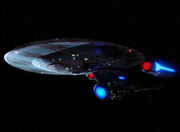
Ambassador-class USS Enterprise NCC-1701-C
The Ambassador-class USS Enterprise-C was the second major federation starship to be introduced after the introduction of the Galaxy-class USS Enterprise-D, the first one having been the kitbashed Constellation-class in the form of the USS Stargazer. Though a significant design variation, utilizing Star Trek: The Next Generation design elements, the design, established as an older one, was only to have a limited presence in the Star Trek-franchise.
Design
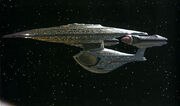
Probert's concept painting of the Ambassador-class
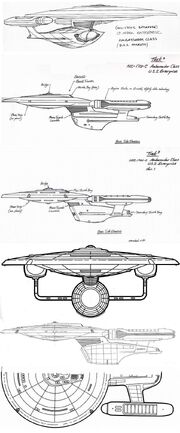
Sternbach's modified design sketches of the Ambassador-class
The studio model was designed by Rick Sternbach, based on sketches as well as on a design concept painting produced by Andrew Probert for the first season of Star Trek: The Next Generation. The design was intended to suggest an intermediate step between the Excelsior-class and the Galaxy-class starships. A relief sculpture of Probert's design was placed in the observation lounge aboard the USS Enterprise-D. Unfortunately, the model was needed for "Yesterday's Enterprise" much sooner than the time it would take to fabricate the smoother lines of Probert's concept, requiring Sternbach's alterations which ended up on Greg Jein's final model. As Sternbach later renumbered, elaborating in detail on his thought processes,
"The deadline for sketching and blueprinting the Ent-C was pretty normal in that I had a few days preproduction to sketch up the ship as first suggested in Andy Probert's color painting, get it approved as an intermediate shape between the Excelsior and the Galaxy classes, and then work up the blueprints. Greg Jein was given the miniature job, as we know. I suppose it took about three or four days to draft up the hull shape. The port elevation sketch was the first and, ultimately, the only sketch view of the Ambassador class Enterprise-C done for the TNG episode "Yesterday's Enterprise." Time constraints dictated that the blueprints and filming miniature be started as soon as possible, and the general look of the ship was quickly approved.
"The genesis of the design came from a small color painting done by Andy Probert back in the early preproduction for Season 1, plus a mental blending of the Excelsior/Enterprise-B and Galaxy class Enterprise-D. While Andy's color sketch showed an elliptical cross section for the engineering hull and an intended elliptical saucer (not clearly visible but confirmed by Andy), the Enterprise-C would require some simplifications if it were to be constructed in time for filming. I began drawing up the blueprints with a circular saucer and a circular cross section for the engineering hull, knowing that they would make model maker Greg Jein's job markedly easier. Swinging compass arcs for the major saucer thickness changes and secondary hull bulkheads took much less time in the drafting stage than calculating ellipses, which is not impossible with pencil and tracing vellum (using something called the trammel method), just tedious. With the basic line work completed for a combined top/bottom view and a fore/aft view, all of the expected details on a Starfleet ship were added. Shield grid lines, phaser strips, lifeboat hatches, reaction control thrusters, running lights, engineering access hatches, and windows populated the surface.
"Understanding Greg Jein's knowledge of starship modeling, I felt comfortable penciling in a single "wedge" of saucer details and then instructing him to repeat the wedge around as necessary, rather than draw every single component. Did anything get left off the blueprints? Torpedo launchers, I think, and maybe a tractor beam emitter or two. Why Greg didn't catch that, I'll never know.
"Once in his hands, Greg added a lot more surface texture in the form of more shield grid lines, as well as a unique paint scheme. The front view was inked (inked?!) to become part of the bridge displays on the Enterprise-C. If you didn't know before, black line art was typically shot on high-contrast negative film and then colored from behind with gels, mounted to light gray smoked plexiglas, and backlit. Okay, you knew that. Today, of course, it's all Adobe Illustrator and Corel Draw and a bunch of other image apps printed out to backlit inkjet film. Anyhow, most of the status displays and engineering cross section diagrams were originally done with black technical pen and Xerox pasteup and thin black crepe tape. Half of a top view could be flopped and copied and pasted together to make a full top view, and incorporated into a control panel.
"One thing you'll notice from the front view is that the nacelles don't peek over the top of the saucer, but rather "look under" the saucer to allow the Bussard collectors to work. Same goes for Voyager and the Enterprise-D. I may have doodled the Ambassador class pylons reaching way up over the saucer but discarded the idea; some shapes just don't feel right, so they get reworked. The nacelles themselves are deliberately a bit oversized, as if Starfleet was experimenting with a new warp coil that was perfected later in the Galaxy class.
"The Enterprise-C was certainly a fun ship to work on despite the short time frame, and to see it come out as a couple of different model kits was an added bonus." [1](X)
Probert revisited(X) his original design in 2007 in preparation for a possible release of a model kit. [2] One of Sternbach's redesign sketches turned up at Propworx's The official STAR TREK prop and costume auction of 8 August 2010 as Lot 320 where it sold for US$480 (including buyers premium), being estimated at US$200-$400.
Studio model
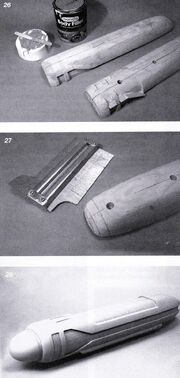
Warp nacelle master under construction at Merriman's workshop
Time constraints also meant that the model was of less quality than normal, but in this particular case this was not necessary since the battle-damaged model was intended to appear only in wide shots on relatively low-resolution TV screens. In order to have the model ready in time Jein also needed the help of subcontractors Ed Miarecki, who constructed the secondary hull master, and David Merriman, Jr., who built the master for the nacelles.
Merriman, who had helped out Jein on previous occasions when the latter found himself in a time pinch (especially when it came to producing warp engines), later recalled,
"I've indicated that Paramount didn't give Greg much lead-time to produce the miniatures for the ST:TNG TV show, Case in point: the Enterprise-C job! The next call from Greg involved his need for another warp engine master for a new Starfleet craft, but he needed it in hand within ten days. Weeeee!... About this time Ellie [remark: Merriman's wife] and I had adopted the playful title of "Warp Engines R Us". Oh well! Better to be type cast and get the work than not to be appreciated for possessing special talents and to not get the work at all.
"The next day the plans arrived. One break presented itself as I studied the drawings: The 1701-C's warp engines were nearly circular in section, permitting me to lathe turn the master from wood and to carve, file and sand it to the final shape, streamlining our work a great deal.
"Turning the Sugar Pine piece on the wood lathe to the shape of the warp engine, I cut in two radial recessed areas forward. The portions of the radial recesses that had to be brought back to the height of the warp engines surfaces were built up with Bondo. Thin gauge plywood sheet barriers defined the borders of the recessed areas. I used a molder's gauge to assure symmetry of the cuts made into the wooden pattern - i.e. the left side was of the same contour as the right. Once roughed out the shape, the master was worked with sandpaper and primer to a smooth finish.
"With a big sigh of relief we sent the 1701-C warp engine master off, not expecting to hear from the West Coast for some time." (Sci-Fi & Fantasy Models, issue 30, p. 39)
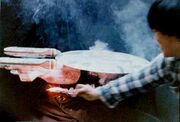
Jein applying battle damage on the studio model
The battle damage on the Enterprise-C was painted on, but Jein also used sparkling fireworks, held close to the model, to apply smudges and scorching, "To simulate the damage on the Enterprise-C, we used a lot of leftover pyro that we had from the Fourth of July, like firecrackers and smoke pots. We actually scorched the surface of the ship rather than painted on it." (Star Trek: The Next Generation 365, p. 138). The model came in at 41.19×26 inches in length and was constructed out of glass fiber reinforced cast resin with styrene details. Both Jein's construction blueprints, as well as Sternbach's orthographic plans prepared for Jein, were upon completion of the model gifted to Gary Kerr, a personal friend of Jein, who used them to draw up his own set of blueprints for intended use in Michael Okuda's canceled Starship Enterprise reference book project. [3](X)
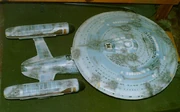
|
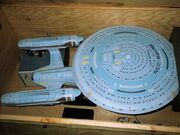
|
The next appearance of the Ambassador-class was as the USS Zhukov in "Data's Day" (misspelled and mislabeled as "USS Zuhkov", NCC-62136). For reasons as of yet undisclosed, the appearance of the model was noticeably changed after it was rehabbed to remove the battle damage it sported as the Enterprise-C. The saucer section's connection to the engineering hull was shifted slightly aft, with the nacelle pylon assembly moved a corresponding distance in the same direction. Cowlings were added around the Bussard collectors, making them appear closer to that of the Galaxy-class. The lower sensor dome became more elaborate and closer in appearance to the Excelsior-class and the deflector dish was modified. Finally, the width of the shuttlebay was increased and a second facility resembling that on the Excelsior-class engineering hull was mounted directly underneath the original one. Graphics were upgraded with the Starfleet insignia of the 2360s. Apart from these changes the layout and the number (from sixteen to twenty) of lifeboat hatches on the bridge module was changed. All these changes befuddled (re)designer Sternbach, who once commented, "Once the drawings and/or blueprints left my desk, I didn't have a whole lot of control over what happened to the models, as evidenced by the weirdness with the Enterprise-C and ships like the Romulan scout and Talerian (Tarelian?) cruiser." [4](X)
The model later appeared in "Redemption II" as the USS Excalibur, as stock footage, thereby appearing both in its original and modified form. It made its final appearance in "Emissary" as the USS Yamaguchi. At the time of its retirement, the studio model bore the markings of both the Excalibur and Yamaguchi. [5] A final modification was to shorten the nacelle pylons, (possibly due to damage done after final filming) and thereby lowering the warp nacelles in their entirety below the saucer section, when the model was briefly considered to make an appearance in Star Trek Generations. [6](X)
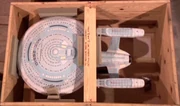
|

|
When the model was no longer deemed suitable enough for an appearance in a live-action production, it was shortly released by the studio for public relations purposes, having been on display in the 1995-1996 London, UK, leg of the European Star Trek: The Exhibition traveling tour, the one and only time the model has been on tour before it was auctioned off in 2006. [7](X) Established as an older design, no CGI model for production purposes was ever created for the class.
The studio model was featured in the documentary Star Trek: Beyond the Final Frontier due to its appearance in Christie's 40 Years of Star Trek: The Collection auction. The model, listed as Lot 694, and estimated at US$8,000-$12,000, was sold on 7 October 2006 with a winning bid of US$40,000 ($48,000 including buyer's premium) to Adrian Hancock, the same British collector who also acquired the USS Voyager and the D'deridex-class studio models. [8] Prior to its sale, the model was on pre-auction views at Christie's London-based auction house from 3 August through 8 August, and subsequently at their New York City-based auction house from 29 September through 4 October, 2006. [9]
Display models

Ambassador display graphic
Aside from the frequent appearances of the Ambassador-class relief sculptures throughout TNG, and later Star Trek Generations and the display model in Star Trek: First Contact through Star Trek Nemesis, there were at least two other depictions of the Ambassador-class appearing on various LCARS displays, including a display shown in "Second Chances", and a classroom "Starship Chronology" display appearing during DS9 Season 2.
The display model in Star Trek: First Contact as one of the golden models in the display case in the observation lounge was a creation of John Eaves. "This was before eBay, so I went and scoured the hobby shops all the way from Los Angeles to PHX Arizona to find any and all kits of the Enterprises. What was available then was the Enterprise A, a TOS Enterprise that was too small so I opted to get the cutaway version that was substantially bigger, and the Ent. D. That left the "B", "C" and the new "E". For the "B" I grabbed one of the Playmates toy which was a good scale. For the "C" my friend Nelson tracked down a beautiful Garage kit that, too, was a good scale. For the "E", I had just finished making a big 28 inch study model for the producers here in LA and for the model guys and gals up at ILM. It was almost too big, but there was no time to sculpt another one so it had to do. Herman asked for 3 of each ship because we were now going to have the smashing of the case scene. In the end, we wound up making 6 of the "D's" and about 6 or 7 of the "C's" because it was the one that all the glass would fall on top of.", Eaves remembers on his blog. [10] Molds were taken of the model and solid resin casts copies were made (since there were multiple takes of the scene). After smoothing out the surfaces, the models were gold electroplated at ArtCraft Plating. The models were subsequently smashed when the scene was filmed.
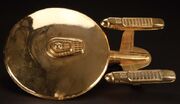
One of the golden models
For Star Trek: Insurrection there were again three models needed (though due to a script change they would not be used there), this time because there were three display cases and Eaves more or less repeated the procedure, this time using an AMT/Ertl model kit (No. 8001), solidifying the models by filling them up with resin. They were seen as display models in the observation lounge in Star Trek Nemesis. [11]
Eaves and the studio initially retained the models but most of them were later sold at various auctions; one was sold as Lot 17 with an estimate of US$800-$1,200 in Propworx' STAR TREK auction III on 24 March 2012 for US$550 ($677 including buyers premium); one sold as part of a complete set of six in the Profiles in History Hollywood Auction 44 on 15 May 2011 as Lot 1550 for US$11,000 (for the whole set); one sold as Lot 9435 in November 2008 in It's A Wrap! sale and auction for US$17,750; one sold as part of a complete set of six in Profile's The Star Trek Auction on 12 December 2001 as Lot 288, estimated at US$10,000-$12,000, again for the whole set, and another one has reportedly been sold in an on-line Sotheby's auction in October 2000. [12]
Derivative franchise use of CGI models

Gidding's Ambassador-class model on the cover of the Official Starships Collection
Whereas no CGI model was ever constructed for live-action production purposes, some were, for reproduction purposes in, by the franchise licensed Star Trek print publications.
The first time an Ambassador-class vessel showed up as CGI imagery in an officially licensed publication, was as the Enterprise-C on the center spread, "Fleet Museum", of the 2006 Star Trek: Ships of the Line calendar, reproduced in its corresponding book of the same year. Though the complete depiction was composed by former Foundation Imaging employee Sean Scott, the model of that particular ship was constructed by his former Foundation colleague Robert Bonchune. The latter revisited his build, and refined it for a far more featured representation in the 2010 reference book USS Enterprise Owners' Workshop Manual.
Later CGI builds were Dan Uyeno and Tobias Richter's versions, which were respectively featured on the February, and June spreads of the 2012 Ships of the Line calendar. Their versions differed form the "official" ones, as they have tried to incorporate more Excelsior-class elements into the design of the former [13](X), as well as some of Probert's original design elements for the latter. [14](X)
A more recent CGI version of the Enterprise-C, was a new model Ed Giddings constructed for the Star Trek: The Official Starships Collection partwork project, managed by Ben Robinson. [15] It has not been clear why Robinson deemed Bonchune's version unsuitable for the project and commissioned a new one, especially considering the fact that Bonchune, as supervisor, was "on staff" of the publication.
Appendices
Further reading
- "Behind the Scenes: Designing the U.S.S. Enterprise NCC-1701-C", Star Trek: The Magazine Volume 3, Issue 4, August 2002, pp. 31-33
- Star Trek: The Official Starships Collection, issue 46, 2015
External links
- Designing the USS Enterprise NCC-1701-C online version at the Federation Starship Datalink
- Ambassador-class variants at Ex Astris Scientia: a full analysis of the modifications made between the Enterprise-C and Yamaguchi models
